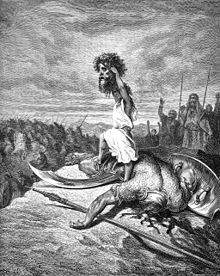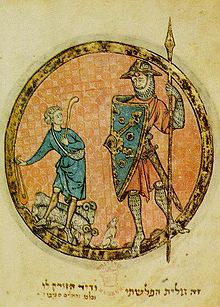Goliath



Goliat , often also Goliath , ( Hebrew גָּלְיָת Golyat ; Arabic جالوت, DMG Ǧālūt ) from Gat is the name of a legendary giant warrior of the Philistines from the Old Testament .
Biblical evidence
In the Old Testament, the figure of Goliath is mentioned in four places:
1. In connection with the election of David as the future king of Israel , 1 Sam 17 EU tells of the duel between young David and a huge warrior of the enemy Philistines. Trusting in God's help, David confronts the mighty enemy and can kill him with his slingshot :
“A pioneer named Goliath from Gath stepped out of the Philistine camp. He was six cubits and a span tall. He had a bronze helmet on his head and he wore a bronze scale armor that weighed five thousand shekels . He had bronze rails on his legs and a bronze sickle sword hung between his shoulders. The shaft of his spear was (as thick) as a weaver's tree and the iron spearhead weighed six hundred shekels. His shield bearer walked before him. "
“As the Philistine advanced further and got closer and closer to David, David also ran quickly from the battle line (of the Israelites) towards the Philistine. He reached into his shepherd's pocket, took out a stone, hurled it, and hit the Philistine on the forehead. The stone penetrated the forehead and the Philistine fell face down to the ground. So David defeated the Philistine with a sling and a stone; he met the Philistine and killed him without a sword in hand. Then David ran and stood next to the Philistine. He took his sword, pulled it out of its scabbard, cut off his head and killed him. When the Philistines saw that their strong man was dead, they fled. "
2.1 Sam 21 EU reports accordingly how David asks for a weapon some time later on his flight from the Israelite King Saul in the sanctuary in Nob and receives the information from the priest Abimelech:
"The sword of the Philistine Goliath, whom you slain in the Terebinthental, lies here (...)."
3. In 2 Sam 21.19 EU , a summary of the heroic deeds of David's followers against powerful opponents, the giant Goliath is placed in a row with three other giant opponents, all four of whom are assigned to the Rafaites . Goliath is killed by Elhanan, the son of Jair from Bethlehem, David is only indirectly involved in the fame as a warlord:
“Isishbi from Nob, a Rafaïter whose bronze spear weighed three hundred shekels and was girded with a new sword, said he would slay David. But Abishai , the son of Zeruja, came to David’s aid and killed the Philistine. After that, Gob had another fight with the Philistines. At that time Sibbechai from Husha slew Sippai, who belonged to the Rafaites. When there was another fight against the Philistines at Gob, Elhanan, the son of Jair from Bethlehem, slew Goliath from Gat, whose spear was like a weaver's tree . Then there was another fight at Gat. Then came a man of gigantic size; He had six fingers on each hand and six toes on each foot, a total of twenty-four; he too was descended from Rafa. When he mocked Israel, Jonathan the son of David's brother Shima killed him. These four were descended from Rafa of Gat; they fell at the hand of David and his warriors. "
4. In the first book of the Chronicle, however, it is described in almost the same summary that Elhanan only kills Goliat's brother :
“At that time Sibbechai from Husha killed Sippai, who belonged to the Rafaites. The Philistines were overthrown. When the battle against the Philistines came once again, Elhanan, the son of Jair, killed Lachmi, Goliath's brother from Gat, whose spear was like a weaver's tree. Then there was another fight at Gat. Then came a man of gigantic size; he had six fingers and six toes each, twenty-four together; he too was descended from Rafa. When he mocked Israel, Jonathan the son of David's brother Shima killed him. These were descended from Rafa from Gat; they fell at the hand of David and his warriors. "
The majority of historical-critical biblical scholarship today assumes that many details of the Goliath story in the Hebrew Bible only emerged shortly before the turn of the century, and that the name Goliath as a designation for David's opponent is not an original part of the story of 1 Samuel 17 but was only added later by a scribe who knew the note about Elhanan's heroic deed. According to this hypothesis, the other account, 2 Samuel 21:19, should be considered the original literary context of the name. When the summaries were later adopted in 1 Chronicles 20, the contradiction found was harmonized accordingly by attributing the killing of Goliat's brother to Elhanan.
In the Old Testament, especially in the book of Joshua, there are other stories about battles with great peoples. In addition to the Rafaites , to whom the two Summaries Goliath belong, also the sons of Anak (Anakites) and the Emites . These narratives of the struggle and victory against the giant peoples of Canaan have primarily no historical, but rather a theological background: By relying unconditionally on Yahweh's leadership, the people of Israel are able to take possession of the promised land .
etymology
The name Goliath itself has no Semitic etymology . According to the hypotheses of the ancestry of the Philistines, the same Indo-European root is assumed for this as in the Lydian name Alyattes. In 2005, a team led by the archaeologist Aren Maeir from the Bar-Ilan University found a pottery shard with an inscription in early Semitic script in the former Philistine city of Gat , on which two names are named that are similar to the name Goliath and suggest that Goliath could well be a name of the Philistines.
Contributions of antiquity
The size of Goliat is given in the scrolls of Qumran as four cubits and a hand's breadth (about two meters), as is the case with the Jewish historian Flavius Josephus and in the Septuagint . In later writings, which form the basis of the Luther Bible and the standard translation , as well as in the Vulgate , its size is even increased to six cubits and a hand's breadth (about three meters).
According to statistical studies by the Israel Antiquities Authority on male skeletons from the Bronze and Iron Ages (3000–500 BC), the average man in Biblical times was about 1.64 m tall. However, there are always finds of significantly larger skeletons (1.85–2.00 m), including from Gezer . It is quite likely that such above-average tall men served as lone fighters and champions in the armies and thus provided a basis for the Goliater story.
Giants also appear in other ancient sources. There are corresponding representations on seals and temple walls from this time. One example is the Abu Simbel Temple of Ramses II in Upper Egypt as well as textual traditions from Syria and Egypt. The Goliater story, for example, shows great resemblance to the ancient Egyptian story of Sinuhe from the Middle Kingdom , in which Sinuhe also kills the strong man from Retjenu with a ruse.
reception
Today, following the biblical account, very great people or things are called Goliaths. If two very unequal opponents compete against each other somewhere, one often speaks of a fight "David against Goliath".
The figure of Goliath has entered many customs. A well-known one is the giant figure of Goliath at the “ Ducasse d'Ath ” festival in Ath (Belgium). The "David and Goliath Game" was widespread in Lungau until the 20th century ; it is performed in Ramingstein .
On one of the Exemplum panels of Elector Joachim II from the workshop of Lucas Cranach the Elder , David's fight against Goliath is depicted (approx. 1540/1545).
Matthias Claudius rhymed the nursery rhyme Was once a giant Goliath, even a dangerous man . The Goliathhaus is located in Regensburg , on the facade of which a monumental wall painting by Melchior Bocksberger (1573) shows the same scene.
In 1960, the Italian Bible adaptation David and Goliath was made .
Dagmar and Klaus Heizmann wrote a children's musical in 2002 with the title David and Goliat .
The Goliath beetle is named after this person because of its size.
literature
- Reiner Andreas Neuschäfer : "How to fencing with honor" or: Matthias Claudius as David in Würselen. "The story of Goliath and David, put into rhyme". In: Annuals of the Claudius Society. 15 (2006), pp. 5-20.
Web links
- The Tell es-Safi / Gath Archeological Project (archaeological and epigraphic findings with further references)
- Stefan Seiler: Goliath. In: Michaela Bauks, Klaus Koenen, Stefan Alkier (Eds.): The Scientific Biblical Lexicon on the Internet (WiBiLex), Stuttgart 2006 ff.
- Terra X: The giant Goliath - On the trail of the sea peoples . TV documentary on YouTube (52:01 min.)
Individual evidence
-
↑ When converting the biblical dimensions , the size of Goliat is almost 3 meters:
6 cubits × 45 cm / cubit + 1 span × 22.5 cm / span = 270 cm + 22.5 cm = 292.5 cm -
↑ When converting the biblical weight specifications , the weight of Goliat's scale armor is 60 kg:
5000 shekels × 12 g / shekels = 60,000 g = 60 kg -
↑ When converting the biblical weight specifications , the weight of Goliat's spearhead is approx. 7 kg:
600 shekels × 12 g / shekels = 7,200 g = 7.2 kg - ^ The Tell es-Safi / Gath Archaeological Project: Overview
- ↑ Was Goliath “just” an elite fighter? Blog “Archaeological Groundbreaking”, scilogs.spektrum.de, December 12, 2007
- ↑ Manfred Görg: Egyptian Religion: Roots - Ways - Effects . Kohlhammer, Stuttgart 2007, p. 69.
- ↑ Niklas Böhmer: David versus Goliath: Everything you need to know about the 52nd Super Bowl. In: Lippische Landes-Zeitung 2018. Lippischer Zeitungsverlag Giesdorf GmbH & Co. KG, February 4, 2018, accessed on February 26, 2018 .
- ^ "David versus Goliath": SC Paderborn versus FC Bayern Munich. In: SKY Sport. Sky Österreich Fernsehen GmbH, February 5, 2018, accessed on February 26, 2018 .
- ↑ Clubs & Customs: David and Goliath ramingstein.at


